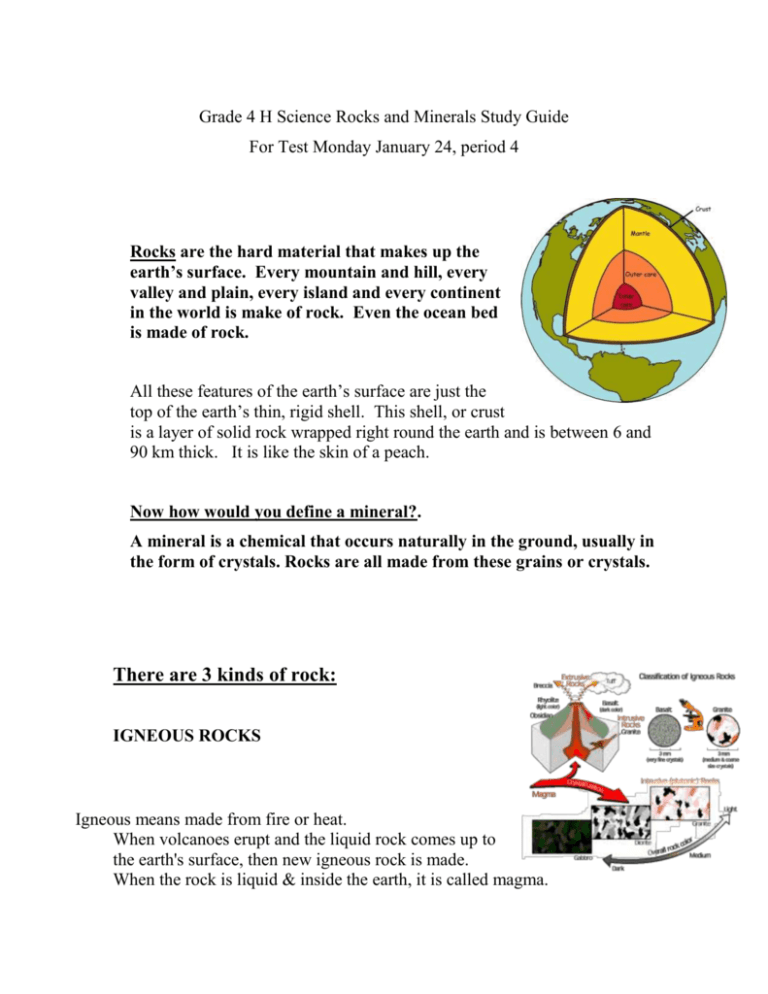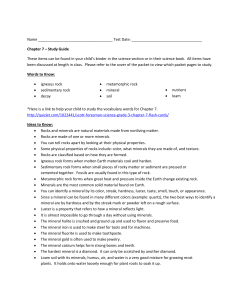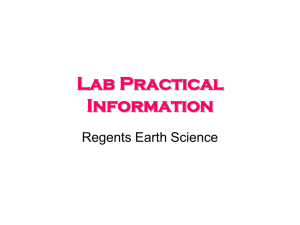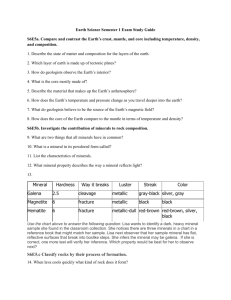Rocks and Minerals Study Guide Jan 20
advertisement

Grade 4 H Science Rocks and Minerals Study Guide For Test Monday January 24, period 4 Rocks are the hard material that makes up the earth’s surface. Every mountain and hill, every valley and plain, every island and every continent in the world is make of rock. Even the ocean bed is made of rock. All these features of the earth’s surface are just the top of the earth’s thin, rigid shell. This shell, or crust is a layer of solid rock wrapped right round the earth and is between 6 and 90 km thick. It is like the skin of a peach. Now how would you define a mineral?. A mineral is a chemical that occurs naturally in the ground, usually in the form of crystals. Rocks are all made from these grains or crystals. There are 3 kinds of rock: IGNEOUS ROCKS Igneous means made from fire or heat. When volcanoes erupt and the liquid rock comes up to the earth's surface, then new igneous rock is made. When the rock is liquid & inside the earth, it is called magma. When the magma gets hard inside the crust, it turns into granite. Most mountains are made of granite. It cools very slowly and is very hard. When the magma gets up to the surface and flows out, like what happens when a volcano erupts, then the liquid is called lava. Lava flows down the sides of the volcano. When it cools & turns hard it is called obsidian, lava rock or pumice - depending on what it looks like. There are 5 kinds of igneous rocks, depending on the mix of minerals in the rocks. Granite Diorite Gabbro Periodotite Pegmatite SEDIMENTARY ROCKS When erosion happens, the little bits of rock wear away get deposited as sediments. Over time, these sediments harden as they get buried by more sediments and turn into sedimentary rocks. These are the only kind of rocks that have fossils. There are 6 main kinds of sedimentary rocks depending on the appearance of the rock. Conglomerate rock has rounded rocks (pebbles, boulders) cemented together. Sandstone is a soft stone that is made when sand grains cement together. Sometimes the sandstone is deposited in layers of different colored sand. Shale is clay that has been hardened and turned into rock. It often breaks apart in large flat sections. Limestone is a rock that contains many fossils and is made of calcium carbonate & or microscopic shells. Gypsum, common salt or Epsom salt is found where sea water precipitates the salt as the water evaporates. Breccia has jagged bits of rock cemented together in a matrix. METAMORPHIC ROCKS Metamorphic rocks were originally igneous or sedimentary, but due to movement of the earth's crust, were changed. If you squeeze your hands together very hard, you will feel heat and pressure. When the earth's crust moves, it causes rocks to get squeezed so hard that the heat causes the rock to change. Metamorphic rocks are the least common of the 3 kinds of rocks. Metamorphic rocks are igneous or sedimentary rocks that have been transformed by great heat or pressure. Slate is transformed shale. It splits into smooth slabs. Schist is the most common metamorphic rock. Marble is transformed limestone. Quartzite is very hard. Physical Properties of Rock: You can divide rocks into many categories. You can make up categories to divide them by but there are official categories that scientists use to describe and identify rocks. Color Color is one of the most basic way to identify a mineral. But then there are always some minerals which are supposed to have more than one color, say for example, Quartz, which can occur in blue, brown, pink, red, purple and almost any other colour, in fact, sometimes colorless as well. Streak Streak refers to the coloured residue left by scratching a mineral across an abrasive surface, such as a tile of unglazed porcelain. A mineral with more than one color will always leave a certain color of streak. For example, Hematite is a mineral that can be seen in red, brown or black, but it will always leave a characteristic reddish brown streak. Luster Luster is the shining property of a mineral. There are two types of luster: Metallic -- A metallic luster is shiny and similar to the reflection from a metal object, such as a faucet. Nonmetallic -- A mineral that does not shine like metal has a nonmetallic luster. For example, the wall has a nonmetallic luster. There are many types of nonmetallic luster. A glassy luster is bright and reflects light like a piece of glass. A greasy luster has an oily appearance. An earthy luster is a very dull and looks like dirt. A Waxy luster looks like the shininess of a crayon. Cleavage One of the tendencies of minerals is to break along flat surfaces. This property is known as Cleavage. Cleavage is rated as good, fair and poor depending how flat it breaks. Minerals having very poor cleavage will only break with a rough surface. Hardness Another important property that scientists use to classify minerals and identify them is the degree of hardness. This degree may vary between 1 to 10, 1 being the softest mineral (talc) and 10 being the hardest (Diamond). Hardness is one of the better properties to use for identifying a mineral. Hardness is a measure of the mineral’s resistance to scratching. The Mohs scale is a set of 10 minerals whose hardness is known. The softest mineral, talc, has a Mohs scale rating of one. Diamond is the hardest mineral and has a rating of ten. Softer minerals can be scratched by harder minerals because the forces that hold the crystals together are weaker and can be broken by the harder mineral. The following is a listing of the minerals of the Mohs scale of Hardness and their rating: 1. Talc 2. Gypsum 3. Calcite 4. Fluorite 5. Apatite 6. Orthoclase Feldspar 7. Quartz 8. Topaz 9. Corundum 10. Diamond For a good explanation of the difference between rocks & minerals, check out http://www.rocks-and-minerals.com/ http://www.rocksforkids.com/RFK/identification.html http://www.minsocam.org/MSA/K12/properties/minpropindex.html









